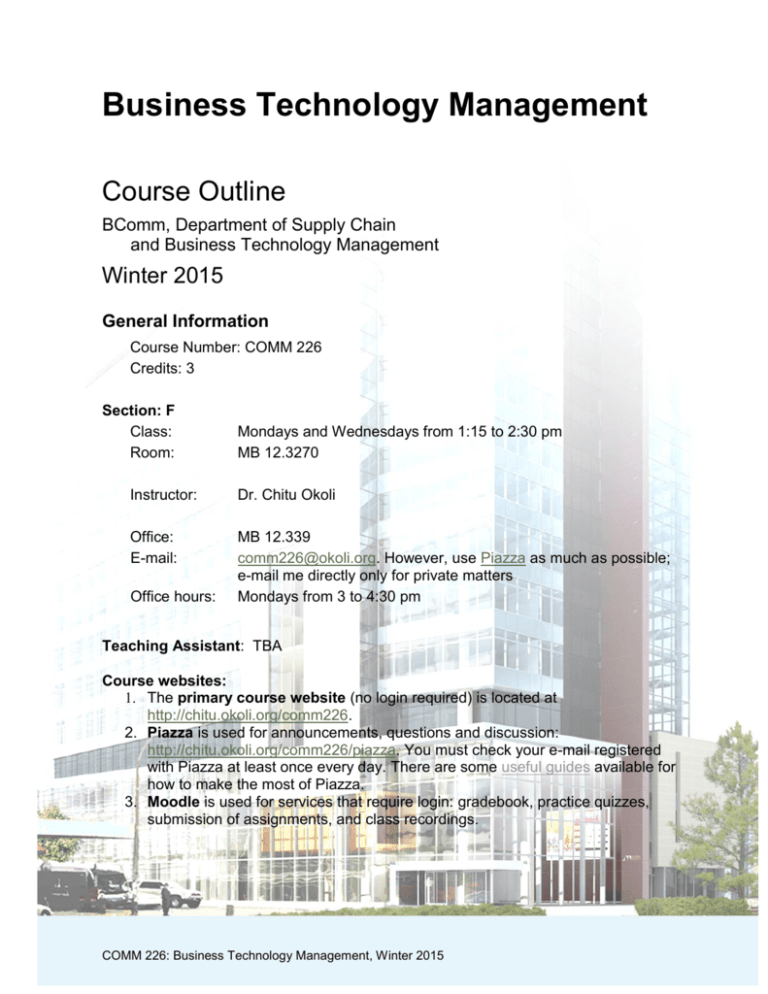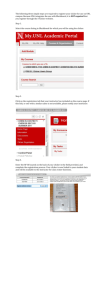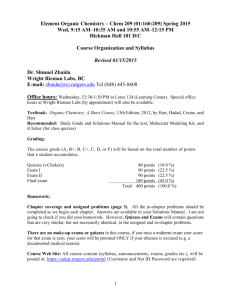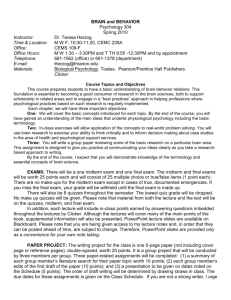Course outline
advertisement

Business Technology Management Course Outline BComm, Department of Supply Chain and Business Technology Management Winter 2015 General Information Course Number: COMM 226 Credits: 3 Section: F Class: Room: Mondays and Wednesdays from 1:15 to 2:30 pm MB 12.3270 Instructor: Dr. Chitu Okoli Office: E-mail: MB 12.339 comm226@okoli.org. However, use Piazza as much as possible; e-mail me directly only for private matters Mondays from 3 to 4:30 pm Office hours: Teaching Assistant: TBA Course websites: 1. The primary course website (no login required) is located at http://chitu.okoli.org/comm226. 2. Piazza is used for announcements, questions and discussion: http://chitu.okoli.org/comm226/piazza. You must check your e-mail registered with Piazza at least once every day. There are some useful guides available for how to make the most of Piazza. 3. Moodle is used for services that require login: gradebook, practice quizzes, submission of assignments, and class recordings. COMM 226: Business Technology Management, Winter 2015 Note You are required to read this Course Outline; it contains information that, if ignored, may result in losing marks in the course. Course description The objective of this course is to provide students with an understanding of the role of information technology in business organizations. Students learn how information technologies can be used to create business value, solve business problems, accomplish corporate goals and achieve and maintain a competitive advantage. Prerequisite: None. Expanded Course Description Information technology dominates the modern business environment. This creates a need for managers that not only understand technology but also know how to use it to create business value for the organization. Business Technology Management (BTM) is a set of processes and services that unite an enterprise's business technology (BT) and business management (BM) strategies to extract total BT solution value potential. The course introduces students to information systems and technology with a focus on its application to help businesses to achieve and maintain a competitive advantage. Modern information systems and approaches used to support organizations in their operations and interactions with other business are emphasized in this course, including enterprise resource planning (ERP), supply chain management (SCM) and customer relationship management (CRM). Database management and design is covered as a tool to improve decision making and to support operations. The use of internet technology as a business tool to expand markets, improve efficiency and facilitate operations is introduced to students with practical business cases. Students are also exposed to information technology risks such as computer crimes and learn how to mitigate them by using information security. This course also provides students with hands-on experience to an ERP system (SAP) and a database system (Microsoft Access). Learning Objectives The main objective of this course is to provide an in-depth understanding of the role of information systems in supporting business activities and enhancing organizations’ competitive advantage. Upon successful completion of this course, students will be able to: Describe the main concepts of information systems and the related concepts; Describe the relationship between information systems and competitive advantage; Identify the major trends in IS technologies such as Customer Relationship Management Systems, Supply Chain Management Systems and Enterprise Resource Planning and their use to improve business efficiency, increase profits and support other business functions; Learn how to use e-commerce and e-business in order to create new or improve existing businesses. Demonstrate how information systems can enhance business decision making and help create business partnerships; Describe how organizations develop, acquire and implement information systems; Discuss issues related to computer crime and security, and information systems ethics. COMM 226: Business Technology Management, Winter 2015 Semester schedule For the up-to-date schedule, please consult http://chitu.okoli.org/bios/pro/teach/comm-226/comm226-schedule-winter-2015/. Course Materials Required Material: COMM 226 BUSINESS TECHNOLOGY MANAGEMENT 2ND EDITION FOR CONCORDIA (ISBN 9781269969567) Alternative option for Textbook: eBook subscription only (ISBN 9781269963046): This option does not include the hardcopy textbook (online textbook only). iClicker You are required to purchase an iClicker for in-class participation. A clicker is a classroom response system that allows you to respond to questions the professor displays during class. You will be graded on your in-class clicker participation (merely answering the questions) and performance (answering the questions correctly). New and used iClickers are available in the bookstore, which also offers a buy-back option. Please read about the iClicker registration! You must register your iClicker by the deadline specified on the course schedule or else you will face the following penalties: No registration before iClicker registration deadline: 10% will be deducted from your final clicker grades No registration before last day of class: You will get zero on all clicker grades Software for assignments You will need various specific software applications for your assignments in this course, such as SAP GUI and Microsoft Access. When each assignment is announced, specific instructions will be provided to obtain and install the required software. Although the SCBTM Department has a computer lab (MB 12.314) that has all the required software installed, the lab is not always open, and so it is best to learn how to run the required software on your own computer. Important Note for Apple Macs users The assignments teach you how to use real-world business software. Unfortunately, much software in the business world does not work well or at all on Apple OS X. Thus, if you use a Mac, you will sometimes need to also run Windows on your Mac. Instructions will be provided for how to do this. Teaching Method Practical examples in class and practice problems are presented in business and economics settings. These examples are drawn from a variety of areas such as accounting, management, finance, marketing, production, economics and business information systems. The teaching methods include: o Lectures with discussion: Important material from the textbook and other sources will be covered. These lecture resources may include presentations, slides, websites, and videos. COMM 226: Business Technology Management, Winter 2015 o o o o o Mini-case studies and discussions: Real or fictional business scenarios may be presented, and there will be in-class and online discussions on how to apply information systems to solve business problems. Clickers and peer instruction: Classroom response technology to facilitate active in-class learning will be used in every class. Further information on clickers is provided on the last page of this outline. Assignments and activities: Students will be required to complete assignments and activities designed to complement and enhance learning of the course material as well as to provide some practical experience of management information systems. Exam: The final exam will take place on the university premises. The final exam will cover the material in the book. The date, time and rooms for the final exam will be determined by the examination office. Panopto class recordings: All class sessions will be recorded using the Panopto system. Specifically, the instructor’s computer screen and the instructor’s voice will be recorded. After each class, you may review the session using the Panopto module in Moodle. This is an optional service to aid your learning; there is no course mark associated with it, so you are free to choose whether or not to use it. Class Preparation and Problem Assignments o o o o o o Understanding of the course material is generally achieved through individual (or group) study, homework assignments, and classroom examples. The instructor will not explicitly cover in class all material that students are expected to learn. Lectures are used to develop an understanding of the more complex issues. It is your responsibility to study the remaining parts of each chapter. Classroom and online examples are used to illustrate the application of material in typical contexts. To maximize your benefit from this course, you should thoroughly read the chapter material prior to each class and try to solve the problems and cases that appear in the Class Schedule. Due to the large class size, not all the questions you have can be answered in class. Please post any remaining questions you might have about the course to the discussion forum on Piazza. Other students, the teaching assistant or the professor will answer your questions. All handouts will be posted on the course website. It is your responsibility to check them and print them before class. Course Evaluation The final grade for the course will be based on the following components: Evaluation Class activities 15% Assignments 25% Assignment 1- SAP (Individual) 7% Assignment 2-ERD and Databases (Groups of maximum two students) 11% Assignment 3 –E-procurement (Individual) Final examination Total COMM 226: Business Technology Management, Winter 2015 7% 60% 100% Details Class activities There will be a variety of in-class learning activities, one of which is clickers use and peer instruction. These will only be counted after the last day to add courses. In any class when you answer “clicker” questions. The lowest 2 marks in the semester will be excluded from the calculation of the clicker participation and performance marks. (Note: details of clicker use are provided later in this document.) Specifically, there are three kinds of graded class activities: Reading quizzes (5%): At the beginning of every topic, there will be a few simple questions to make sure that you have completed the assigned reading before class. The reading quizzes must be done individually, closed book. You will be graded based on each correct answer. In-class participation (5%): During most class sessions, there will be various questions to which you will respond with your clicker. These questions may be individual, done with partners, or with open textbook, unless otherwise specified. There might or might not be one correct answer. For these questions, you will receive a participation mark for merely answering the questions and a performance mark for your correct answers. In-class activities (5%): During a few class sessions, there will be small group activities. For these activities, you will submit your work and will be graded thus: 10 (sincere effort made), 5 (weak effort made) or 0 (no effort or no submission). Assignments There are three assignments during the semester; please refer to the schedule for the due dates. Assignments 1 and 3 are individual, Assignment 2 can be done as an individual or by groups of maximum two students. Assignments 1 and 2 comprise two parts each. Assignment 3 requires that y register in Week 8. Note that this assignment begins in week 12, if you do not register by week 11, then you will get zero for this assignment (registration after week 9 carries a penalty of 10% per week). Final examination The final examination is worth 60% of the total mark for this course. However, in order to pass the course, you must score at least 50% in the final examination. The final examination is comprehensive; it will cover all of the chapters and sections of the textbook listed above. The final examination will have both multiple choice questions and word problems. Disclaimer Note: In the event of extraordinary circumstances beyond the University's control, the content and/or evaluation scheme in this course is subject to change. Late assignments class policy: Late assignments, for any reason, will be subject to a 20% penalty for the first day. An additional 10% will be deducted for each additional day. COMM 226: Business Technology Management, Winter 2015 Numerical Score and Letter Grades At the end of this course, the instructor will produce an overall score for the student’s performance on the various components of this course, and then convert that score to a letter grade. The following list provides the numerical equivalent for the letter grades that will be reported at the end of the term: Letter and Number Grades Letter A+ A AB+ B BC+ C CD+ D DFNS Score 90 85 80 77 73 70 67 63 60 57 53 50 0 - 100 89 84 79 76 72 69 66 62 59 56 52 49 * D- is the minimum requirement to pass the course. Please refer to section 16.3 of the Undergraduate Calendar for more information about the grading system, examinations, and performance requirements. (http://registrar.concordia.ca/calendar/16/16.html#16.3) COMM 226: Business Technology Management, Winter 2015 Assessment of Learning Objectives Learning Outcomes Final exam Describe the main concepts of information systems and the related concepts Theory-based multiple-choice exam questions and applicationbased exam questions Describe the relationship between information systems and competitive advantage Identify the major trends in IS technologies such as SCRM, SCM and ERP and their use to improve business efficiency, increase profits and support other business functions Learn how to use Ecommerce and Ebusiness in order to create new or improve existing businesses Demonstrate how information systems can enhance business decision making and help create business partnerships Describe how organizations analyze, develop, acquire and implement information systems Discuss issues related to computer crime and security, and information systems ethics Asgn. 1 Business process modelling and notation Use of an ERP Theory-based Use of an multiple-choice ERP exam questions and applicationbased exam questions Theory-based Use of an multiple-choice ERP exam questions and applicationbased exam questions Theory-based multiple-choice exam questions and applicationbased exam questions Theory-based multiple-choice exam questions and applicationbased exam questions Theory-based multiple-choice exam questions and applicationbased exam questions Theory-based multiple-choice exam questions and applicationbased exam questions Asgn. 2 Asgn. 3 Database Design for a business case Class activities Reading quizzes and participation questions Use of an Reading quizzes and eparticipation questions procureme nt system Use of an Reading quizzes and eparticipation questions; inprocureme class activities nt systems Use of an Reading quizzes and eparticipation questions; inprocureme class activities nt systems Implementat ion of a database system Business process modelling and notation Use of an Reading quizzes and eparticipation questions procureme nt systems Design and implementat ion of a database system COMM 226: Business Technology Management, Winter 2015 Reading quizzes and participation questions; inclass activities Reading quizzes and participation questions Clicker FAQ’s: o Why do we use clickers? research on learning reports the following: • When you actively participate in learning, you retain the knowledge longer than you would if you passively listened to the lecture. • When you answer questions, you remember the answers better than if you were just told the answers to the questions. • You will remember the answers even more when you discuss it with other students before answering. This “peer instruction” has been found to improve in-class learning. o How do we use clickers in class? In each class, typically the following steps are repeated: • Professor explains a topic • A multiple choice question is displayed • You read the question and answer it using your clicker • You then discuss your answer with at least 2-3 other students seated near you • You answer the question once again using your clicker (your answer may or may not be the same as your first answer) • The distribution of the responses (anonymous) and the correct answer are displayed. • Depending on the distribution of the answers, the topic of the question is discussed o What are some other benefits of “clicker exercise”? • It provides immediate feedback to you about your level of knowledge of the topic of the question compared to the other students in the class. • It provides feedback to the professor by alerting her to topics that were not clearly understood by the majority of the students in the class. The professor immediately responds by providing further clarifications. • It is an objective way of giving credit for your class preparation and participation • It is fun! (several students from various universities, reported this – I agree as well) o What do I need to do to benefit from this interactive learning activity? You will need to prepare for each class by familiarizing yourself with the topic before class. Without preparation, this learning activity can easily deteriorate into a “mindless clicking” exercise which defeats its purpose. A more detailed guideline on preparing for class is provided below. o What are former students who have used clickers in another course I have taught saying about it? Below are some comments from former students: • “i-clickers are a good way to keep the class interesting and helps us stay up to date.” • “The clicker questions are very effective” • “I-clicker is a very good idea since it forces students to go to class and participate.” • “I find the clicker questions a good way to get participation marks.” • “I really liked the clicker questions, and we went over everything in great detail.” • “I really like the concept of working with clickers because it makes you think on your feet and reflect on the material that has just been covered.” • “I also like the concept of clickers as it really evaluates students’ understanding of the theories.” • “She should keep using clicker questions to help students understand what they are reading in the textbook” o How do I register my i-Clicker? 1. Log in to the MyConcordia Portal at http://www.myconcordia.ca 2. In the MyConcordia menu, select "Student Services". 3. Select " i-Clicker Registration". 4. Enter your i-Clicker ID (the number on the back of the i-Clicker remote) and click "Enter". COMM 226: Business Technology Management, Winter 2015 Academic Integrity The most common offense under the Academic Code of Conduct is plagiarism, which the Code defines as “the presentation of the work of another person as one’s own or without proper acknowledgement.” This could be material copied word for word from books, journals, internet sites, professor’s course notes, etc. It could be material that is paraphrased but closely resembles the original source. It could be the work of a fellow student, for example, an answer on a quiz, data for a lab report, a paper or assignment completed by another student. It might be a paper purchased through one of the many available sources. Plagiarism does not refer to words alone - it can also refer to copying images, graphs, tables, and ideas. “Presentation” is not limited to written work. It also includes oral presentations, computer assignments and artistic works. Finally, if you translate the work of another person into French or English and do not cite the source, this is also plagiarism. Clickers: Bringing someone else’s clicker to class and answering for them constitutes cheating. It will be dealt with in the same manner as cheating. In Simple Words: DO NOT COPY, PARAPHRASE OR TRANSLATE ANYTHING FROM ANYWHERE WITHOUT SAYING FROM WHERE YOU OBTAINED IT! (Source: The Academic Integrity Website: http://provost.concordia.ca/academicintegrity/plagiarism/) Classroom etiquette In order to maintain a classroom atmosphere that is conducive for learning where everyone respects each other, please take care of the following principles of classroom etiquette during class time: Browsing websites: Please do not browse on any website that is not directly related to the class material (e.g. Facebook, e-mail, news, sports, etc.). Not only does this distract you so that you cannot learn, but it also distracts others who can see your screen. Texting, e-mail, messaging, etc.: Please do not text, e-mail or message anyone during class. Talking during class: Please do not chat with seatmates about anything that is not directly related to class content. If you need to talk to a classmate about class content while the instructor or another student is speaking or during other class activities, then talk quietly and briefly so as not to distract anyone. Cell phones: You are not required to turn off your cell phone, but you are responsible if it rings. If it is an emergency, then apologize to the class and walk out of the classroom to take the call. If not an emergency, then apologize to the class and do not answer the phone. Packing up early: It is rude to start packing your bags before class is over. Please wait until the instructor officially dismisses the class. Leaving class early: It is rude to leave the classroom early without explanation. If you must leave the class early, then please notify the instructor at the beginning of class. Support Services Concordia University offers many on-campus support services that are available to students free of charge. The web link http://www.concordia.ca/students/help4u.html is a useful facility that guides students to a specific support service that can provide appropriate assistance. COMM 226: Business Technology Management, Winter 2015






